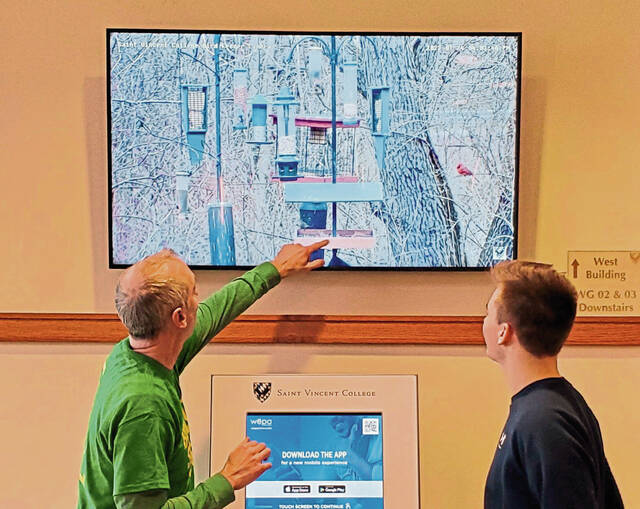Wildlife livestream helps 'bring the outdoors in' for Saint Vincent students
Bill Powers of Murrysville is on the lookout for a pileated woodpecker nest somewhere on his property. And Saint Vincent biology professor Jim Kellam is just the man to help him find it.
Their mutual appreciation for wildlife has led to the installation of a TV at the Dupre Science Pavilion at the Unity college campus, livestreaming a feed from the Winnie Palmer Nature Reserve.
The camera is installed on a bird feeder at the reserve and is available to the public via a YouTube livestream on PixCam’s website.
“I supervise undergraduate research students, and, as an ornithologist, a number of my students want to do bird research,” Kellam said.
One student did his senior project on the social relationship of birds at feeders, “so he went out to the Palmer reserve four or five days a week and tracked how the birds interacted with one another — how much time they spent at the feeder, who went first,” Kellam said. “And even when our campus was closed by snow, he needed the data, so he trudged through the snow and sat out there.”
With the camera, which has been in place since summer, students can observe birds remotely. And with the new livestream, students of all scientific disciplines will get a chance to see what is at the feeder.
“The feeder camera will be helpful in future projects,” Kellam said. “But it also exposes students to nature as they’re on their way to class. It reminds us to think about nature and about wild animals, and how close they are to us. They’re everywhere and we don’t notice them enough.”
Kellam and Powers are developing technology that will enable them to “notice” even more birds in the near future.
“We have been developing something called Birdnet- Pi,” Kellam said. “It’s a microphone that listens to the birds and sends that information to an artificial intelligence server that identifies the species making the sound.”
Powers, who owns PixCams in Murrysville and is best known for the Hays bald eagle camera (where he recently saw that the eagles have begun laying eggs), said Birdnet-Pi is able to distinguish and recognize “pretty much all the birds you’ll hear in the U.S. and especially along the Appalachian Mountain range.”
“It’s great because you hear a lot more than you see,” he said.
But Kellam and Powers also will be seeing more soon when they install an array of cameras on property adjacent to Saint Vincent College, which recently was acquired by the Westmoreland Land Trust.
“The trust has 250 acres, and it’s more of a mixed, wooded-and-field area,” Powers said. “It’s a great opportunity that brings the trust into the mix and also brings some bigger educational outreach opportunities.”
One such opportunity is livestreaming a pileated woodpecker’s nest. Powers believes a woodpecker he’s seen around his property has a nest, and he has recruited Kellam and his students to help locate it.
“I’ve found dozens over my career and been published on them,” Kellam said. “We tried last spring and didn’t find it. But if it’s on this property, we’re going to keep looking until we find it.”
In the meantime, they’ll have to settle for the more than 20 live feeds that are up and running, including everything from an osprey nest at Moraine State Park to nine nest cameras in screech owl boxes in a remote wooded area.
Kellam said he hopes the cameras and the video screen at the Dupre Science Pavilion will “bring the outdoors in” for students and the public.
“It’ll help increase the visibility for — and, hopefully, a greater love for — nature,” he said.
Patrick Varine is a TribLive reporter covering Delmont, Export and Murrysville. He is a Western Pennsylvania native and joined the Trib in 2010 after working as a reporter and editor with the former Dover Post Co. in Delaware. He can be reached at pvarine@triblive.com.
Remove the ads from your TribLIVE reading experience but still support the journalists who create the content with TribLIVE Ad-Free.


